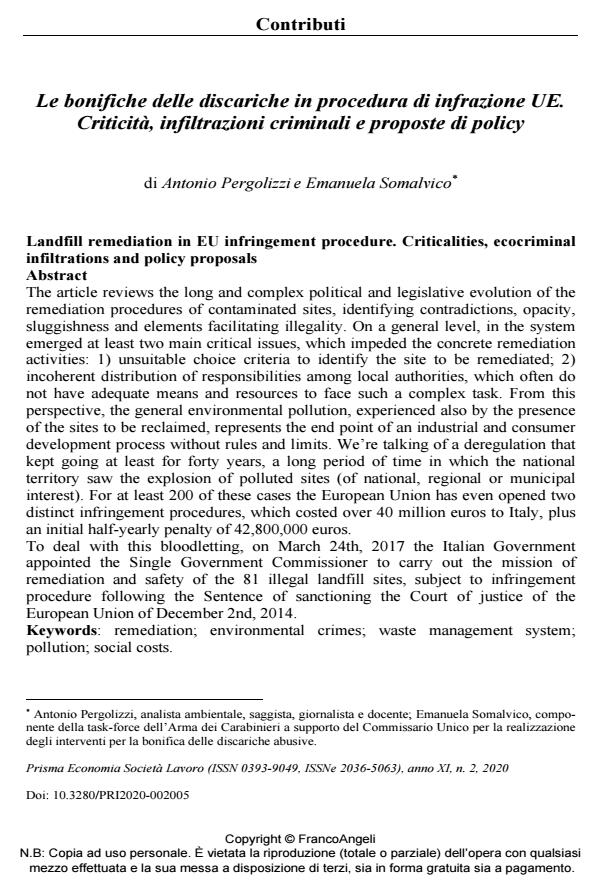Landfill remediation in EU infringement procedure. Criticalities, ecocriminal infiltrations and policy proposals
Journal title PRISMA Economia - Società - Lavoro
Author/s Antonio Pergolizzi, Emanuela Somalvico
Publishing Year 2022 Issue 2020/2
Language Italian Pages 15 P. 68-82 File size 235 KB
DOI 10.3280/PRI2020-002005
DOI is like a bar code for intellectual property: to have more infomation
click here
Below, you can see the article first page
If you want to buy this article in PDF format, you can do it, following the instructions to buy download credits

FrancoAngeli is member of Publishers International Linking Association, Inc (PILA), a not-for-profit association which run the CrossRef service enabling links to and from online scholarly content.
The article reviews the long and complex political and legislative evolution of the remediation procedures of contaminated sites, identifying contradictions, opacity, sluggishness and elements facilitating illegality. On a general level, in the system emerged at least two main critical issues, which impeded the concrete remediation activities: 1) unsuitable choice criteria to identify the site to be remediated; 2) incoherent distribution of responsibilities among local authorities, which often do not have adequate means and resources to face such a complex task. From this perspective, the general environmental pollution, experienced also by the presence of the sites to be reclaimed, represents the end point of an industrial and consumer development process without rules and limits. We’re talking of a deregulation that kept going at least for forty years, a long period of time in which the national territory saw the explosion of polluted sites (of national, regional or municipal interest). For at least 200 of these cases the European Union has even opened two distinct infringement procedures, which costed over 40 million euros to Italy, plus an initial half-yearly penalty of 42,800,000 euros. To deal with this bloodletting, on March 24th, 2017 the Italian Government appointed the Single Government Commissioner to carry out the mission of remediation and safety of the 81 illegal landfill sites, subject to infringement procedure following the Sentence of sanctioning the Court of justice of the European Union of December 2nd, 2014.
Keywords: remediation; environmental crimes; waste management system; pollution; social costs.
- A.N.A.C. (2019) La corruzione in Italia (2016-2019). Numeri, luoghi e contropartite del malaffare.
- Araneo F., Bartolucci E (2021) “Lo stato delle bonifiche e dei siti contaminati in Italia: i dati regionali”, Istituto Superiore per la Protezione e Ricerca Ambientale, Area per la caratterizzazione e la protezione dei suoli e per i siti contaminati.
- Bator F. M. (1958) “The Anatomy of Market Failure”, Quarterly Journal of Economics.
- Camera dei deputati, Commissione parlamentare di inchiesta sulle attività illecite connesse al ciclo dei rifiuti e su illeciti ambientali ad esse correlati, Atti e documenti 2016-2021.
- Camera dei deputati, Commissione parlamentare d’inchiesta sul fenomeno delle mafie (2018), Relazione finale.
- Capano G., Gualmini E. (2011) Le pubbliche amministrazioni in Italia, il Mulino.
- Cassese S. (1992) “Maladministration e rimedi”, Il Foro Italiano, V, pp. 244-250.
- Ciuffoletti Z. (1986) “Le bonifiche in Italia”, Atti del Convegno di Castiglione della Pescaia, Castiglione della Pescaia, 26-27 settembre.
- Cowen T. (1988) The theory of market failure. A critical examination, George Mason University Press: Fairfax.
- Della Porta D., Vannucci A. (2007) Mani impunite, Laterza.
- Della Porta D., Vannucci A. (2021) La corruzione come sistema, il Mulino.
- Diamond J. (2004) Collasso. Come le società scelgono di morire o vivere, Einaudi.
- Fontana R., Calò E. D. Cassella M. (2019) On the Reasons for an Informal Economy in Italy: The Motivations of Entrepreneurs and Workers, in Larsen C. et. al. Assessing Informal Employment and Skills Needs, Rainer Hampp Verlag.
- Giuffrida R. (2012) Diritto europeo dell’ambiente, Giappichelli Editore.
- Iovene B. (2008) Campania infelix, BUR Biblioteca Univ. Rizzoli.
- Laffont J.-J. (2008) Externalities, in The New Palgrave Dictionary of Economics, Palgrave Macmillan (eds).
- Legambiente (2014 e 2018) Bonifiche dei siti inquinati: chimera o realtà? (prima e seconda edizione)”.
- Ministero per la Transizione Ecologica/ISPRA (2019), Annuario Siti Contaminati di Interesse Regionale.
- Nature (2014) A toxic legacy, n.508.
- Pellegrini S. (2018) L’impresa grigia. Le infiltrazioni mafiose nell’economia legale. Un’indagine sociologico-giuridica, Ediesse.
- Pellizoni L. (2011) Conflitti ambientali. Esperti, politica e istituzioni nelle controversie ecologiche, il Mulino.
- Pergolizzi A. (2018) Emergenza green corruption. Come la corruzione divora l’ambiente, Andrea Pacilli Editore.
- Pergolizzi A. (2020) Dalla parte dei rifiuti. La governance, l’economia, la società, lo storytelling e i trafficanti, Andrea Pacilli Editore.
- Piratsu R. et al. (2010) Studio Epidemiologico Nazionale dei Territori e degli Insediamenti Esposti a Rischio da Inquinamento: valutazione della evidenza epidemiologica, in Progetto SENTIERI, Istituto Superiore di Sanità, Ministero della Salute.
- Rabitti P. (2008) Ecoballe, Aliberti Editore.
- Sciarrone R. (2015) La mafia, le mafie: capitale sociale, area grigia, espansione territoriale, Istituto dell’Enciclopedia Italiana (L’Italia e le sue Regioni), pp. 263-281.
- Siebert H. (2008) Economics of the Environment, Springer.
- Stiglitz J. E. (1998) “The Private Uses of Public Interests: Incentives and Institutions”, Journal of Economic Perspectives.
- Vannucci A. (2012) Atlante della corruzione, EGA.
- Yang Z. (2020) The Environment and Externality, Cambridge University Press: Cambridge.
Antonio Pergolizzi, Emanuela Somalvico, Le bonifiche delle discariche in procedura di infrazione UE. Criticità, infiltrazioni criminali e proposte di policy in "PRISMA Economia - Società - Lavoro" 2/2020, pp 68-82, DOI: 10.3280/PRI2020-002005